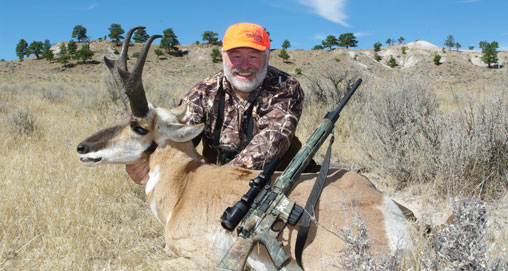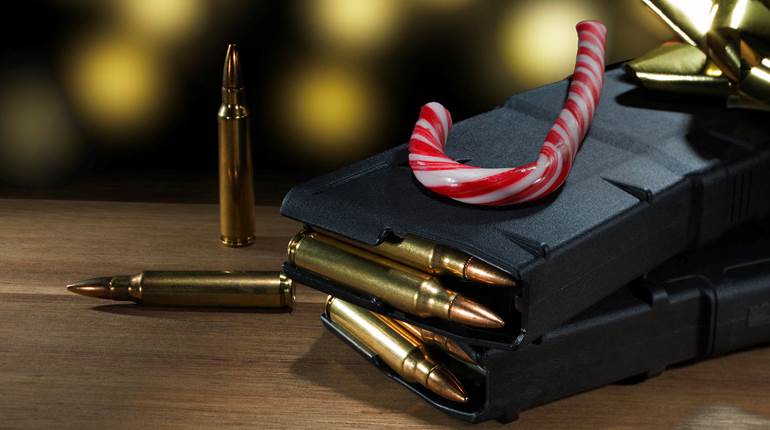
The increasing use of AR-15s for hunting identified a void in the lineup of available cartridges: there was no mainstream, .30-cal. cartridge for the platform. There was the 7.62x39 mm, but it was designed for a much different rifle, and as such the tapered case had compatibility issues with AR-15 magazines.
Freedom Group, the parent company of Remington and DPMS, decided to use its resources to develop just such a cartridge. Called the .30 Rem. AR, it first appeared at an outdoor writers seminar in October 2008; however, it was mid-2010 before guns and ammunition started to appear on dealers’ shelves.
Make no mistake, the .30 Rem. AR is not to be confused with the older .30 Rem. Although the two cartridges have the same internal case capacity—44 grains of water, which is almost the same as the .30-30 Win.—the new cartridge operates at a higher pressure level than the .30 Rem. The SAAMI Maximum Average Pressure (MAP) for the .30 Rem. AR is 55,000 p.s.i. The .30 Rem. was never rated in p.s.i., but with the older c.u.p. rating it’s listed for 35,000 c.u.p., and the .30-30 Win. is rated at 38,000 c.u.p. For comparison, the .30-30 Win. has a MAP of 42,000 p.s.i.
There are claims that the .30 Rem. AR matches the .308 Win. in performance. This is not only wrong, but dangerous. The .308 Win. is rated by SAAMI with a MAP of 62,000 p.s.i., and it has a case capacity of 56 grains of water. There is no possible way that the .30 Rem. AR can safely match the ballistics of a .308 Win. Be forewarned.
Although the .30 Rem. AR is not, and never will be, the equivalent of the .308 Win., it’s not a .30-30 Win., either. With its higher pressure rating it will outperform the .30-30 Win. by a comfortable margin. The reality is that the .30 Rem. AR is on par with the performance of the .300 Savage. Considering the .300 Savage was one of the most popular deer cartridges ever made, that’s pretty good company.
The .30 Rem. AR is a short-fat cartridge with an odd lineage. In 1963 Winchester introduced the .284 Win. for its Model 88 and Model 100 rifles. This short-action cartridge featured a rebated rim, which was pretty close to cutting edge at the time. The .284 Win. was shortened and straightened to become the .450 Bushmaster, a big-bore cartridge designed specifically for the AR-style rifle. For the .30 Rem. AR, Remington and DPMS worked together to shorten the case a bit more and neck it down to .30 caliber using a 25-degree shoulder. The rim was made larger, to 0.492 inches versus 0.472 inches for the .450 Bushmaster, so that the .30 Rem. AR could not be used with bolts designed for the .450 Bushmaster. Because of the .30 Rem. AR’s higher pressure, DPMS (the sister company that builds the rifles for Remington) developed a way to use an AR-10 bolt and barrel extension in an AR-15 rifle.
The .30 Rem. AR has proven to be a very handloader-friendly cartridge. This cartridge performs well with bullets in the 100- to 150-grain weight range. Lightweight bullets can go faster than 3,000 fps. That makes bullets like the Hornady 110-grain V-Max or the Sierra or Speer 110-grain hollow-point bullets excellent for varmint hunting. For bigger game, Barnes’ 110-grain TTSX bullet or the new, easier-expanding 110-grain Triple-Shock SBR bullet it designed specifically for the .30 Rem. AR should be ideal. (Note: This bullet is not a catalog item, but it can be ordered from Barnes.)
The mid-weight 125- to 130-grain bullets achieve a good balance of weight and velocity. But, they lack enough sectional density for serious big-game hunting on anything much larger than medium-size deer. Like the .300 Savage it emulates, the .30 Rem. AR will shine brightest hunting whitetails in the woods with 150-grain bullets.
The key is to use a soft bullet that will expand at the modest velocity this cartridge produces. The Nosler Ballistic Tip or Hornady SST are good choices. Bullets designed for the .30-30 Win. are perfect for deer hunting. I had expected to experience problems with feeding in an AR-style rifle using flat-nose .30-30 Win.-type bullets, but I shot Sierra 150-grain and Speer 130-grain flat-nose bullets without issue. The Hornady 160-grain Flex Tip bullet is another good choice as it is designed for .30-30 Win. velocities, but it offers a higher ballistic coefficient (.330) than the flat-nose bullets.
The .30 Rem. AR’s overall cartridge length is 2.260 inches, and bullets should be seated to that length to start. The limiting factor on cartridge length is the magazine, and if you try to push the limits with a longer seating depth you may find that the cartridges bind up in the magazine.
Whenever loading hunting ammunition for an AR-type rifle it’s important to full-length size the cases. These rifles have only moderate spring power to close the bolt and the case must slip easily into the chamber. Of course, you must check the case length and trim if it is longer than 1.530 inches.
Primers must be seated fully as high primers can cause slam fires or prevent AR actions from completely closing. The Hodgdon data uses Remington 71/2 primers. I also used some CCI 400 with excellent results. Standard small rifle primers work fine for most loads, but don’t rule out a magnum primer if you are using ball-type propellant and are experiencing accuracy problems or high standard deviations. Of course, you must reduce the propellant charge if you switch to a magnum primer and work back up to a safe maximum load.
The only available tested data of which I am aware is from Hodgdon. The data lists several propellants for the cartridge. From its list, I had very good results using IMR 8208 XBR for the mid- to heavy-weight bullets and Hodgdon H4198 for the 110-grain projectiles. I used one of my favorites, the old standby H335, for the 150-grain Sierra flat-nose loads. Although I didn’t have any on-hand when I was working up the loads, Hodgdon’s Ron Reiber says that H322 is probably the best of the bunch. The thing is, using the Hodgdon data, I never found a bad load; however, I didn’t try every single load, either.
The .30-30 Win. changed the world of deer hunting, and this little cartridge could do the same. If the AR-15 lives long and prospers as a big-game rifle, it may well be due to the .30 Rem. AR.






































